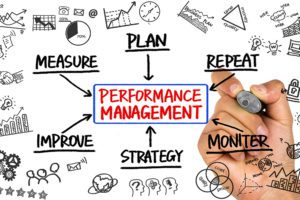Share
Vague goals, like New Year’s resolutions, are easily forgotten. A resolution to “get healthy” might not last a week while you debate investing in a gym membership. Likewise, employee goals need even more detailed structure than fitness goals, including measuring and tracking progress.
How can companies ensure employee goals are not only appropriately set, but also accurately tracked, set up for success, and celebrated when completed? Check out our tips for setting, measuring, and tracking employee goals with the help of HR technology:
Develop SMART goals
The first step is setting the right kind of goals. Make sure employee goals are:
- Well defined without being impossible
- Specific to jobs and the company overall
- Attached to important metrics
These parameters can be accomplished via SMART goals that are Specific, Measurable, Achievable, Relevant, and Timely.
- Specific: Define a clear target. Exactly ow much work is expected in a certain period of time? What type of result shows that the employee has done good work?
- Measurable: Metrics allow you to define progress, improvement, and success. KPIS, QA scores, completed tasks, hourly productivity, and other measurements are useful for SMART goals.
- Achievable: Optional stretch goals can have bonus incentives attached, but SMART goals should be realistic without relying on extreme effort or luck. Falling short of ambitious goals can be unnecessarily discouraging. Keep goals sustainable for steady progress without burnout.
- Relevant: Objectives and metrics should make sense from the employee’s perspective, and they should add to the success of the business. Avoid goals that over-emphasize arbitrary and unimportant details.
- Timely: Without rushing or sacrificing quality, goals should have a realistic timeframe. Open-ended goals tend to lack a sense of urgency, but short deadlines can lead to shortcuts and unnecessary stress.
Align company, team, personal employee goals
Employee goals need to work for the individual employee, but they also need to align with larger goals at the workplace. Consider how your metrics align with team, company, and personal goals:
- Team: Everyone has a role to play within their department. A majority of each worker’s goals should contribute toward the productivity of their team or department. Allow teams to collaborate on shared goals, and in some cases, compete against other teams.
- Company: Likewise, each team and department has its place in the success of the business. Employee goals should reflect that connection between corporate and individual success. Give the whole workforce a sense of solidarity by setting company-wide goals.
- Personal: Workers have their own personal goals like professional development and leadership ambitions. Individual goals can include additional training. Remote workers who struggle to maintain their work-life balance can have a goal of finishing tasks during “windowed work” hours.
Set clear objectives and deadlines
When employee goals are defined and revisited during 1-on-1s and reviews, those meetings provide natural intervals to evaluate progress. Specific, measurable, and timely goals should have clear objectives and deadlines. The deadline won’t always coincide with the next meeting, especially with long term personal goals and career development.
New skills and training may be gradually added over a period of years, but a Learning Management System (LMS) tracks of those individual sessions and the progress of each employee. Use an LMS to cross-train employees so that professional development can make teams more resilient and interconnected while enabling employees to learn and grow.
Continuously measure, learn, and adapt
As you progress, employee goals need to be constantly adapted and tracked. HR data integration software makes it possible to automatically track the productivity of workers, teams, and the whole company.
After a group training or memo addresses a particular issue like missed punches, you can compare data from before and after to look for behavior change. Use alerts and reporting to find out whether time and attendance policies are properly followed
READ: Collecting and Utilizing The Right Employee Review Data
When staff aren’t on track to achieve their goals, live reporting allows you to respond before deadlines have been missed. If employees are invested in meeting the goals, then periodic updates may be enough to provide extra motivation.
Motivation and incentives
What types of incentives would be appropriate for your workplace? A lighthearted competition between departments could have pizza or doughnuts as the reward for a successful month. On the other hand, more serious goals and achievements could be trivialized with a reward like pizza.
Stretch goals and long term milestones may be factored into decisions for annual bonuses and salary increases. As you continue to encourage employees to push further, it shouldn’t feel like the “goalposts” are being moved, so it’s important not to be misleading or vague about incentives.
Some goals like professional development will serve as their own rewards. If you’ve aligned a personal training program with your worker’s career goals, then they’ll appreciate having access to those training materials. Even when promotions aren’t available, you can use special projects and team collaboration as opportunities to let workers test their new skills and abilities.
Utilize performance management software
Need to overhaul your employee review process? Consider the benefits of Performance Management Software. Reviews are just as important as other HR and management routines, but they’re often built around manual reporting and inconsistent data collection. HR software can make employee reviews more impactful and efficient by automatically collecting a wider range of data.
- Track performance over time: Automatic reporting allows you to compare weekly and quarterly productivity, making it easy to measure improvement over time. When an employee has long term performance issues, bonus incentives may not address the underlying problems.
- Compare to other employees: Every employee has unique skills and preferences, but they still need to be productive members of the team. HR software makes it easier to make apples-to-apples comparisons between different workers.
- Track progress: When you set productivity goals or plan a series of training sessions to close skill gaps, HR software allows for clear documentation and accountability. If an employee struggles with tardiness or missed punches, then you can easily track improvement in that behavior.
- Meeting agenda, commenting, kudos–all in one place: Specialized performance management software allows you to do significantly more than schedule meetings and send documents. Capture all the essentials from comments to kudos in one system, recording notes and praise for future reference and encouragement.
Make data based decisions
The employee review process needs to be structured and fair. Performance management software allows you to collect a wider range of data for analysis on employee goals.
Reporting isn’t limited to big picture questions like reporting to executives on HR. Instead, you can bring a data driven approach to managing individual employees. Look at productivity over time and compare output across individuals and across departments.
Data analysis doesn’t give the whole picture, but it can add context. Ideally, reporting should help identify underlying problems and possible solutions. It’s not just about identifying when employees fall short of productivity goals–reviews and goals should help everyone succeed together.
Discover how Netchex can help you set, track, and manage employee goals:
Industry news & tips sent straight to your inbox!
Enter your email below to subscribe to industry news, product updates, and tips.
Related articles

Six HR Metrics to Quantify and Track Manager Effectiveness

Understanding 9-Box Reporting for Performance Management

7 Must-Haves for Successful Employee Review Process

